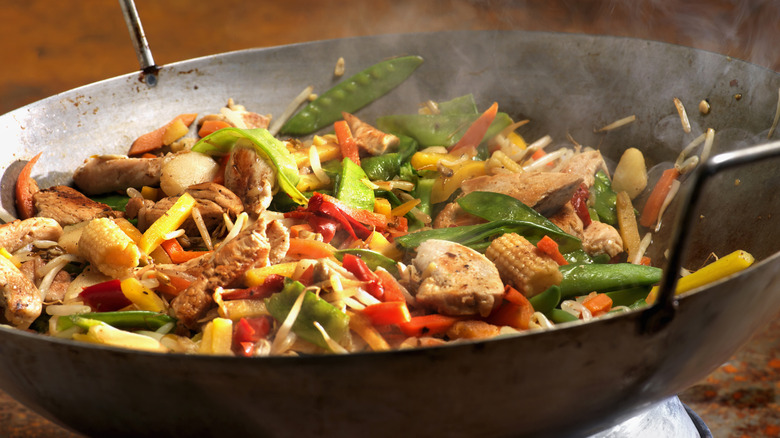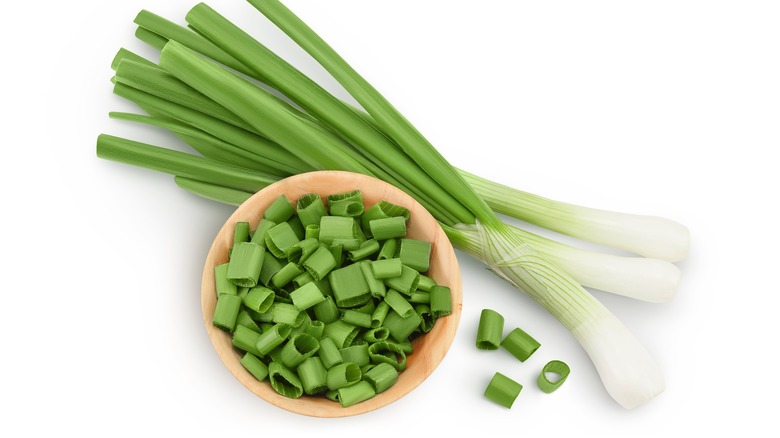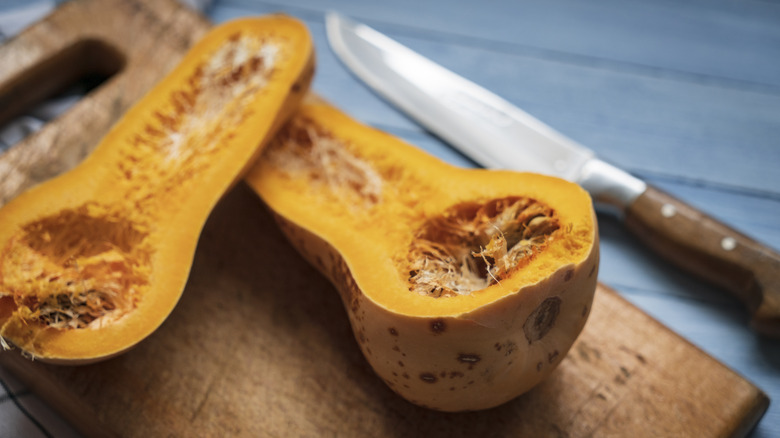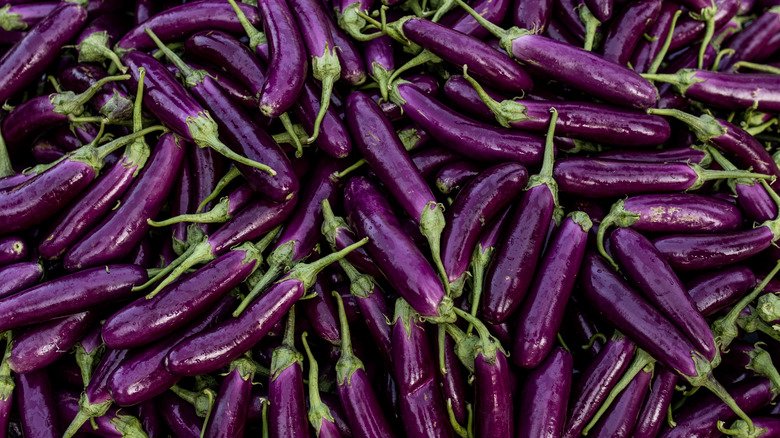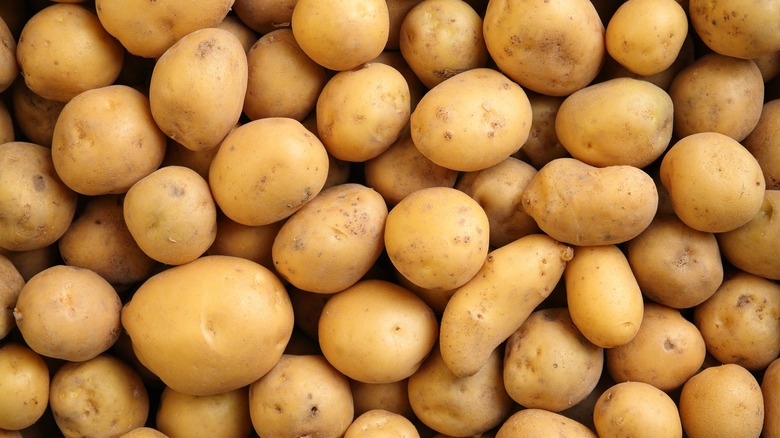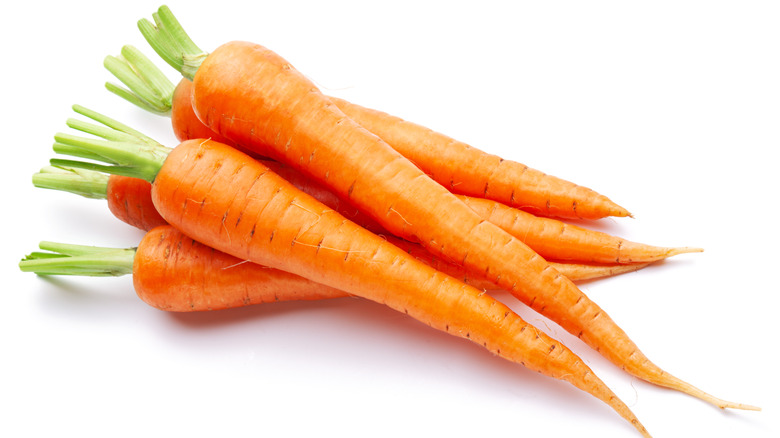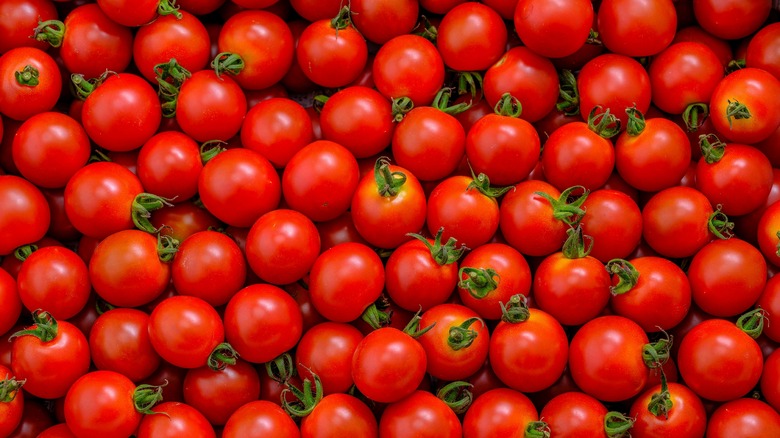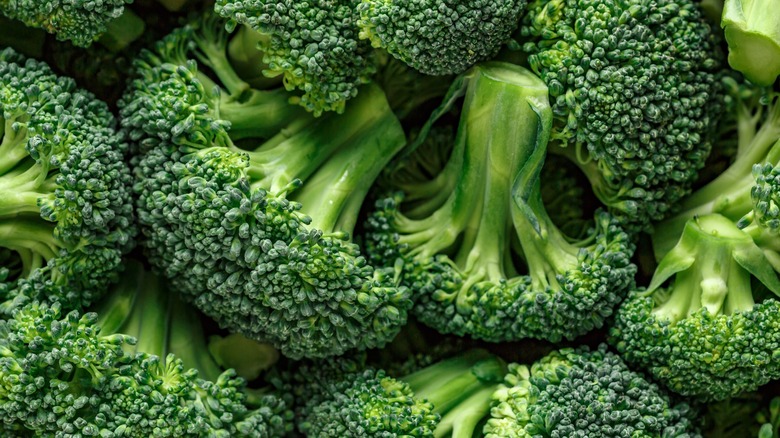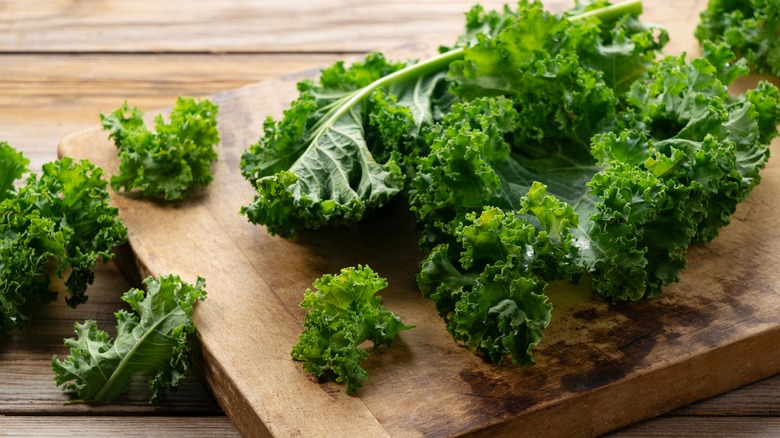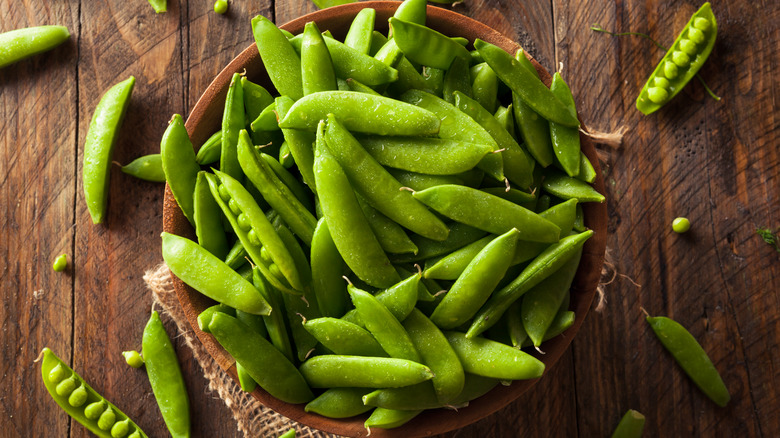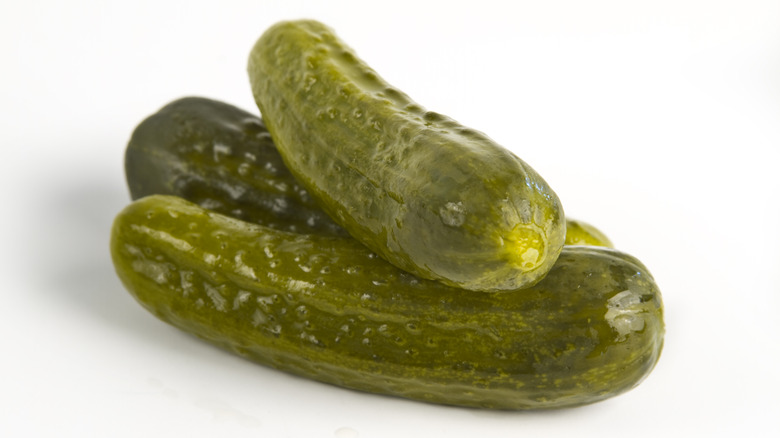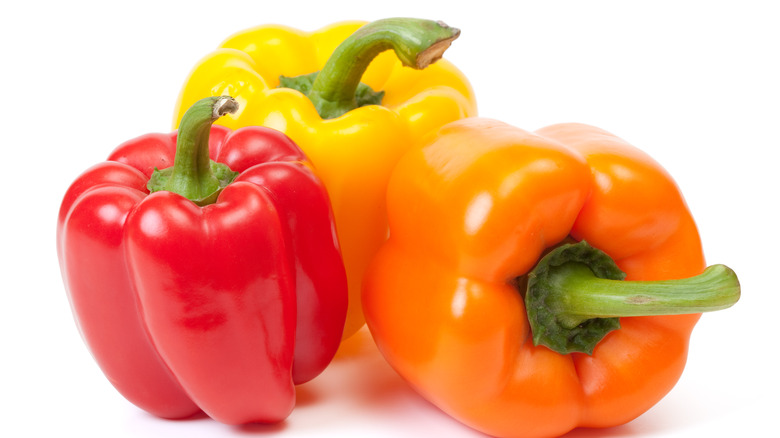6 Best And 5 Worst Vegetables To Stir Fry
Stir fry is a quick and easy way to add some Asian flavor to your weeknight dinners. This dish traditionally involves cooking vegetables and a protein like chicken breast or beef over very high heat in a wok, which makes the ingredients cook up fast and crispy. While there are many ingredients involved in stir fry — the sauce, the meat, the oil, and the garnish, broadly speaking — the most important one is the vegetables. Even if you add meat to your stir fry, it is almost always the vegetables that stand out the most. But which ones should you use?
There are thousands of recipes out there for stir fry with dozens of different vegetable choices. Basically, you can use whatever vegetables you like ... but you should be aware that some work much better than others. The best stay crisp and give your stir fry a nice crunch, while the worst turn mushy over the high heat and make everything soggy and mildly gross. Most stir fry experts recommend choosing just two vegetables to cook with so that you can better coordinate their cooking time, but it can be difficult to pick them when you haven't cooked this dish before. Luckily, we're here to help. Here's a list of the vegetables you absolutely should use in stir fries — and those that you absolutely should leave out.
Best: Green onion
Traditional Chinese stir fry always starts with the "three Gs." This stands for garlic, ginger, and green onion, all of which serve as the essential base for any and all stir fries. Chopped ginger and minced garlic are fairly self-explanatory, but the onion part can cause some confusion, because not every onion is cut out to be cut up for stir fry.
To belong in the three G squad, the onion must be green onion, which you may have also heard referred to as scallions. This type of onion has a milder, gentler taste than your usual white or red onions. Some are harvested from regular onion crops when they are young and still look like tiny bulbs or shoots, while others are their own variety of onions that never form the characteristic onion bulbs at all. What we refer to as scallions are usually the long white stem of this vegetable, while what we call green onions are cut from the darker green part at the top of it.
Worst: Squash
With the exception of zucchini (which can actually make a lovely addition to your stir fry), squash is one ingredient that should be kept far away from your wok. This is because squash contains a lot of water and as it cooks, that water seeps out and into the dish, making everything soggy. Squash is also not usually a quick-cooking vegetable. It's best for dishes that involve baking or roasting, so that it can become soft and flavorful over time in the oven — which is basically opposite from how stir fries are made.
There is a potential exception to this rule, however: You can deep fry squash in oil with a tempura coating. This keeps the moisture inside the veggie while helping the outside cook up crispy and crunchy. Notably, though, this can't really be added to a stir fry, unless you toss it in at the end — otherwise it will get burnt or become mushy anyway. But it's always an option if you want to create your own kind of dish, or you're feeling especially daring.
Best: Eggplant
Eggplants are not always given the appreciation and popularity they deserve in the U.S., but make no mistake: They are delicious, and an excellent addition to Asian-inspired stir fries. The preferred option here is the Japanese eggplant (also known as the Chinese or Asian eggplant) which is long and narrow. It has soft purple skin and fewer seeds than the more rotund eggplants you might be familiar with, although either type can work.
You can find Asian eggplants at some grocery stores, but if you don't see them there, check out an Asian-specific store or a farmer's market. Once you've found them (or bought some of the round ones instead), wash them and cut them into one-inch-thick pieces. Sear them in a hot pan to brown the outside and keep the liquid inside, then add the other ingredients for your stir fry. It's important to keep an eye on them and make sure that they're sautéing and not steaming; the latter approach may cause them to fall apart and have a wet, squishy consistency.
Worst: Potatoes
The potato is one of the most useful, versatile vegetables there is. You can use spuds in anything from soups to French fries to mashed potatoes to roasts. But there is one thing you shouldn't do with them: stir fry.
While it's technically possible to use potatoes in your stir fry, the reality is complicated. Potatoes have a tendency to get burned on the outside before they get cooked on the inside. This is because the starch they contain caramelizes quickly, leaving the outside brown and the inside raw. Since the whole idea behind stir fry is to cook things over a high heat very quickly, potatoes just don't work.
They might (emphasis on might) work, however, if you do a bit of extra prep work. Soaking your potatoes for a few hours can help to remove that starch on their surface — but your work isn't finished there. Next, you have to par-cook them, which means boiling them in salty water for five minutes so they start to soften. Finally, you have to let them dry completely on a paper towel. Then, and only then, can you attempt to pan fry them in a bit of oil.
Best: Carrots
Carrots are one of the most popular stir fry ingredients, hands down. They have a nice flavor without being overwhelming, work with just about every vegetable you can think of, and usually stay their nice, crispy selves in a stir fry, giving your dish that characteristic crunch.
Even better? You can start with either raw carrots or frozen ones. If you use frozen carrots, you should let them thaw out before adding them to the pan. Some recipes recommend blanching or steaming them for a bit first, but whether you do or don't, a julienne peeler is a must. This essential kitchen tool cuts your carrots into perfect strips that cook evenly and quickly, which saves a lot of time and frustration. While some vegetables have to be cooked longer or ahead of time, carrots can be eaten raw, which means that it isn't as important for them to be thoroughly cooked. Since this is the case, you can add them to the wok after the stir fry sauce and the protein have been tossed in.
Worst: Tomatoes
Tomatoes, like potatoes, are an extremely versatile and well-loved vegetable. But — just like with potatoes — using them in stir fry is inadvisable. There are two main reasons why tomatoes should not see the inside of the wok. The first is that they're just too watery. Stir fries are known for their crisp vegetables. This is something that is almost impossible to achieve with tomatoes, which not only get soggy on their own when they cook, but also release water, making everything else soggy as well.
The second reason is a science-based one. Tomatoes should not be used in a cast iron pan like a wok because their acidity creates a chemical reaction with the pan that strips away the cast iron's seasoning, resulting in food that doesn't cook evenly (in this instance and in any future dish you try to prepare in it). It also just really tastes bad. While it might be okay to cook tomatoes in a cast iron pan for a couple of minutes, the longer they're there, the more their acidity eats away at the pan and the more the tomatoes themselves take on a strong, metallic taste that will completely ruin your stir fry.
Best: Broccoli
Broccoli is another one of the most popular stir fry ingredients around. This is because it tastes great when it's lightly cooked and crisp, and it lends the dish a pop of bright green color. To use it in your stir fry, start by chopping the broccoli up into small florets so that it cooks more quickly. Then, pre-cook the florets for around five minutes, either by steaming or blanching them. Next, add them to the wok and stir fry with other vegetables that will also get done in around 6 to 10 minutes (or adjust your additions accordingly based on the estimated cooking time for each vegetable). Remember that the smaller you cut the broccoli, the faster it will cook — keep an eye on it!
If broccoli isn't your jam, you can substitute it with cauliflower, which you can cook in the exact same way. You can also use both, as these two very similar vegetables always work very well together.
Worst: Kale
Even though kale is part of the cruciferous vegetable family alongside broccoli and cauliflower (and is a fantastic source of vitamins A, C, and K to boot), it does not work well in stir fry. It can be very bitter, which means that it doesn't play well with many other ingredients. It can also be tough if you don't cut off the larger, thicker stems, and the leaves themselves can get soggy, over-saturated, and just plain icky if they're cooked too long, or in a dish that has a lot of added moisture.
Not cooking kale long enough also comes with its own set of gastrointestinal issues, which is extra problematic for a quick-cooking dish like stir fry. Raw or under-cooked kale can be difficult for the digestive system to process and can cause abdominal issues like gas and bloating. Even if you cook it thoroughly enough, a stir fry still isn't a good way to eat kale, because the process takes away its nutrients, proteins, and antioxidant properties.
Best: Peas
Both sugar snap peas and snow peas are a favorite when it comes to stir fries. They cook well and quickly, and retain a nice, firm bite. They can work both with other vegetables and on their own, making them great for a full meal or as a side dish. Be sure, however, to use peas that are still in the pod, as loose peas may give you different results.
When picking pea pods to use for your stir fry, it's important to look closely. Choose peas with a firm pod with no marks or imperfections. Then, cut off any stems that may remain and pull off the string that runs down the middle of the pod, which can be fibrous. Wash the peas thoroughly. At this point, you can stir fry them with some garlic or other aromatics. It should take around three to five minutes for the peas to turn a nice bright green color and become crisp-tender. You can finish them off with some salt, pepper, sesame seeds, and toasted sesame oil, according to taste. If you're cooking them in a stir fry with other vegetables, keep their quick cooking time — typically between 3 and 5 minutes — in mind and choose your additions accordingly.
Worst: Pickles
First, a bit of disambiguation. For this section, we are talking about pickled cucumbers, which most people refer to simply as "pickles," "gherkins," etc., not about other vegetables that have been pickled. The latter can go quite well in a stir fry, if properly drained first. But the former will give you some odd, off-puttingly tangy results.
Pickles, whether they are sweet, dill, or bread and butter, have a very strong taste thanks to their fermentation process in brine with various herbs, spices, and seeds. If you add them to a stir fry, that taste will quickly cover up any other flavor you have going with a heavy layer of vinegar. Pickles can also change consistency when they're heated, and may turn out burnt or mushy if you try to fry them in a pan with other vegetables. These types of pickles are best left for sandwiches, potato salads, or even pasta salads, where they can add a bit of zing without taking over the whole dish.
Best: Bell peppers
It doesn't get better than bell peppers when it comes to stir fry ingredients. These tasty vegetables can go with anything: broccoli, carrots, eggplant, meat, fish ... basically every ingredient you can imagine. They're beautifully colored, which makes your dish look awesome, and they're thin enough to cook well when cut into strips. They can be eaten raw as well, which means that even if you don't cook them to the point where they're soft all the way through, they're still totally tasty and entirely edible.
For a fast dinner option, you can easily whip up a tasty beef stir fry using one medium green or yellow bell pepper and one red one, plus a pound of sirloin or steak. Both the meat and the peppers should be cut into strips, with the meat being tenderized and pounded to around 1/4 inch thick. Heat some oil in your wok, adding some sliced onions (and garlic and ginger, if you want to use those three Gs) and the peppers, then cook for just a few minutes until they're all slightly tender. Replace them with the beef and sauté before adding the vegetables back in and cooking everything together until the dish is your desired level of done. Add some salt and pepper to taste, and you're ready to eat.
